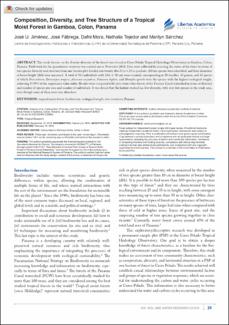El sistema se apagará debido a tareas habituales de mantenimiento. Por favor, guarde su trabajo y desconéctese.
Mostrar el registro sencillo del ítem
Composition, Diversity, and Tree Structure of a Tropical Moist Forest in Gamboa, Colon, Panama
| dc.contributor.author | Jiménez, José Ulises | |
| dc.contributor.author | Fábrega, José | |
| dc.contributor.author | Mora, Dafni | |
| dc.contributor.author | Tejedor, Nathalia | |
| dc.contributor.author | Sánchez, Marilyn | |
| dc.date.accessioned | 2018-03-23T16:14:37Z | |
| dc.date.accessioned | 2018-03-23T16:14:37Z | |
| dc.date.available | 2018-03-23T16:14:37Z | |
| dc.date.available | 2018-03-23T16:14:37Z | |
| dc.date.issued | 2016-03-22 | |
| dc.date.issued | 2016-03-22 | |
| dc.identifier | http://journals.sagepub.com/doi/abs/10.4137/ASWR.S33960 | |
| dc.identifier.issn | 1178-6221 | |
| dc.identifier.uri | http://ridda2.utp.ac.pa/handle/123456789/4451 | |
| dc.identifier.uri | http://ridda2.utp.ac.pa/handle/123456789/4451 | |
| dc.description | This study focuses on the floristic diversity of the forest trees found at Cerro Pelado Tropical Hydrology Observatory in Gamboa, Colon, Panama. Field work for the quantitative inventory was carried out in November 2012. Data were collected by assessing the status of the forest in terms of tree species diversity and structure from one-hectare plot divided into twenty-five 20 m × 20 m quadrats. All tree species were identified, and their diameters at breast height (dbh) were measured. A total of 384 individuals with (dbh ≥ 10 cm) were counted, corresponding to 28 families, 41 genera, and 43 species of which Pera arborea, Oenocarpus mapora, Amaioua corymbosa, Vantanea depleta, and Matayba apetala were the species with the highest ecological weight, achieving 57.99% of the importance value index. Results were compared with plots from other forests of the Panama Canal watershed in terms of diversity and number of species per area and number of individuals. It was found that the habitat studied has low diversity, with very few species in the study area, even though some of them were very abundant. | en_US |
| dc.description.abstract | This study focuses on the floristic diversity of the forest trees found at Cerro Pelado Tropical Hydrology Observatory in Gamboa, Colon, Panama. Field work for the quantitative inventory was carried out in November 2012. Data were collected by assessing the status of the forest in terms of tree species diversity and structure from one-hectare plot divided into twenty-five 20 m × 20 m quadrats. All tree species were identified, and their diameters at breast height (dbh) were measured. A total of 384 individuals with (dbh ≥ 10 cm) were counted, corresponding to 28 families, 41 genera, and 43 species of which Pera arborea, Oenocarpus mapora, Amaioua corymbosa, Vantanea depleta, and Matayba apetala were the species with the highest ecological weight, achieving 57.99% of the importance value index. Results were compared with plots from other forests of the Panama Canal watershed in terms of diversity and number of species per area and number of individuals. It was found that the habitat studied has low diversity, with very few species in the study area, even though some of them were very abundant. | en_US |
| dc.language | eng | |
| dc.language.iso | eng | en_US |
| dc.rights | https://creativecommons.org/licenses/by-nc-sa/4.0/ | |
| dc.rights | info:eu-repo/semantics/openAccess | |
| dc.subject | tropical moist forest | en_US |
| dc.subject | biodiversity | en_US |
| dc.subject | ecological weight | en_US |
| dc.subject | tree inventory | en_US |
| dc.subject | Panama | en_US |
| dc.subject | tropical moist forest | |
| dc.subject | biodiversity | |
| dc.subject | ecological weight | |
| dc.subject | tree inventory | |
| dc.subject | Panama | |
| dc.title | Composition, Diversity, and Tree Structure of a Tropical Moist Forest in Gamboa, Colon, Panama | en_US |
| dc.type | info:eu-repo/semantics/article | |
| dc.type | info:eu-repo/semantics/publishedVersion |
